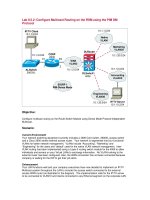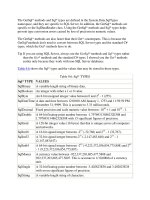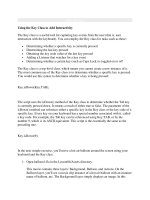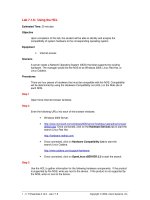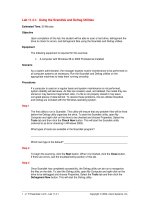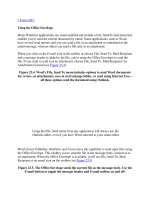USING THE FREERTOS REAL TIME KERNEL docx
Bạn đang xem bản rút gọn của tài liệu. Xem và tải ngay bản đầy đủ của tài liệu tại đây (1.8 MB, 163 trang )
USING THE F
REE
RTOS
REAL TIME KERNEL
A Practical Guide
Richard Barry
This page intentionally left blank
© 2009 Richard Barry
All text, source code and diagrams are the exclusive property of Richard Barry. Distribution or
publication in any form is strictly prohibited without prior written authority from Richard Barry.
FreeRTOS™, FreeRTOS.org™ and the FreeRTOS logo are trade marks of Richard Barry.
Version 1.0.5
FreeRTOS
Designed For Microcontrollers;
i
© 2009 Richard Barry. Distribution or publication in any form is strictly prohibited.
CONTENTS
CONTENTS I
LIST OF FIGURES V
LIST OF CODE LISTINGS VI
LIST OF TABLES IX
LIST OF NOTATION X
CHAPTER 1 TASK MANAGEMENT 1
1.1 C
HAPTER
I
NTRODUCTION AND
S
COPE
2
An Introduction to Multi Tasking in Small Embedded Systems 2
A Note About Terminology 2
Scope 3
1.2 T
ASK
F
UNCTIONS
4
1.3 T
OP
L
EVEL
T
ASK
S
TATES
5
1.4 C
REATING
T
ASKS
6
xTaskCreate() API Function 6
Example 1. Creating Tasks 8
Example 2. Using the Task Parameter 12
1.5 T
ASK
P
RIORITIES
15
Example 3. Experimenting with priorities 16
1.6 E
XPANDING THE
‘N
OT
R
UNNING
’
S
TATE
19
The Blocked State 19
The Suspended State 19
The Ready State 20
Completing the State Transition Diagram 20
Example 4. Using the Blocked state to create a delay 20
vTaskDelayUntil() API function 24
1.7 T
HE
I
DLE
T
ASK AND THE
I
DLE
T
ASK
H
OOK
29
Idle Task Hook Functions 29
Limitations on the Implementation of Idle Task Hook Functions 29
Example 7. Defining an Idle Task Hook Function 30
1.8 C
HANGING THE
P
RIORITY OF A
T
ASK
32
vTaskPrioritySet() API function 32
uxTaskPriorityGet() API function 32
Example 8. Changing task priorities 33
1.9 D
ELETING A
T
ASK
38
FreeRTOS
Designed For Microcontrollers;
ii
© 2009 Richard Barry. Distribution or publication in any form is strictly prohibited.
vTaskDelete() API function 38
Example 9. Deleting tasks 39
1.10 T
HE
S
CHEDULING
A
LGORITHM
–
A
S
UMMARY
42
Prioritized Preemptive Scheduling 42
Selecting Task Priorities 43
Co-operative Scheduling 44
CHAPTER 2 QUEUE MANAGEMENT 45
2.1 C
HAPTER
I
NTRODUCTION AND
S
COPE
46
Scope 46
2.2 C
HARACTERISTICS OF A
Q
UEUE
47
Data Storage 47
Access by Multiple Tasks 47
Blocking on Queue Reads 47
Blocking on Queue Writes 47
2.3 U
SING A
Q
UEUE
49
xQueueCreate() API Function 49
xQueueSendToBack() and xQueueSendToFront() API Functions 50
xQueueReceive() and xQueuePeek() API Functions 51
uxQueueMessagesWaiting() API Function 53
Example 10. Blocking When Receiving From a Queue 54
Using Queues to Transfer Compound Types 58
Example 11. Blocking When Sending to a Queue / Sending Structures on a Queue 59
2.4 W
ORKING WITH
L
ARGE
D
ATA
66
CHAPTER 3 INTERRUPT MANAGEMENT 67
3.1 C
HAPTER
I
NTRODUCTION AND
S
COPE
68
Events 68
Scope 68
3.2 D
EFERRED
I
NTERRUPT PROCESSING
69
Binary Semaphores used for Synchronization 69
vSemaphoreCreateBinary() API Function 70
xSemaphoreTake() API Function 72
xSemaphoreGiveFromISR() API Function 74
Example 12. Using a Binary Semaphore to Synchronize a Task with an Interrupt 75
3.3 C
OUNTING
S
EMAPHORES
80
xSemaphoreCreateCounting() API Function 83
Example 13. Using a Counting Semaphore to Synchronize a Task with an Interrupt 84
3.4 U
SING
Q
UEUES WITHIN AN
I
NTERRUPT
S
ERVICE
R
OUTINE
87
xQueueSendToFrontFromISR() and xQueueSendToBackFromISR() API Functions 87
Efficient Queue Usage 88
FreeRTOS
Designed For Microcontrollers;
iii
© 2009 Richard Barry. Distribution or publication in any form is strictly prohibited.
Example 14. Sending and Receiving on a Queue from Within an Interrupt 89
3.5 I
NTERRUPT
N
ESTING
94
A Note to ARM Cortex M3 Users 95
CHAPTER 4 RESOURCE MANAGEMENT 96
4.1 C
HAPTER
I
NTRODUCTION AND
S
COPE
97
Mutual Exclusion 100
Scope 100
4.2 C
RITICAL
S
ECTIONS AND
S
USPENDING THE
S
CHEDULER
101
Basic Critical Sections 101
Suspending (or Locking) the Scheduler 102
vTaskSuspendAll() API Function 103
xTaskResumeAll() API Function 103
4.3 M
UTEXES
(
AND BINARY SEMAPHORES
) 105
xSemaphoreCreateMutex() API Function 107
Example 15. Rewriting vPrintString() to Use a Semaphore 107
Priority Inversion 111
Priority Inheritance 112
Deadlock (or Deadly Embrace) 113
4.4 G
ATEKEEPER
T
ASKS
115
Example 16. Re-writing vPrintString() to Use a Gatekeeper Task 115
CHAPTER 5 MEMORY MANAGEMENT 121
5.1 C
HAPTER
I
NTRODUCTION AND
S
COPE
122
Scope 123
5.2 E
XAMPLE
M
EMORY
A
LLOCATION
S
CHEMES
124
Heap_1.c 124
Heap_2.c 124
Heap_3.c 126
CHAPTER 6 TROUBLE SHOOTING 128
6.1 C
HAPTER
I
NTRODUCTION AND
S
COPE
129
printf-stdarg.c 129
6.2 S
TACK
O
VERFLOW
130
uxTaskGetStackHighWaterMark() API Function 130
Run Time Stack Checking - Overview 131
Run Time Stack Checking - Method 1 131
Run Time Stack Checking - Method 2 131
6.3 O
THER
C
OMMON
S
OURCES OF
E
RROR
133
Symptom: Adding a Simple Task to a Demo Causes the Demo to Crash 133
Symptom: Using an API Function Within an Interrupt Causes the Application to Crash 133
Symptom: Sometimes the Application Crashes within an Interrupt Service Routine 133
FreeRTOS
Designed For Microcontrollers;
iv
© 2009 Richard Barry. Distribution or publication in any form is strictly prohibited.
Symptom: The Scheduler Crashes When Attempting to Start the First Task 133
Symptom: Critical Sections Do Not Nest Correctly 134
Symptom: The Application Crashes Even Before the Scheduler is Started 134
Symptom: Calling API Functions While the Scheduler is Suspended Causes the Application to
Crash 134
Symptom: The Prototype For pxPortInitialiseStack() Causes Compilation to Fail 134
APPENDIX 1: BUILDING THE EXAMPLES 135
APPENDIX 2: THE DEMO APPLICATIONS 136
APPENDIX 3: FREERTOS FILES AND DIRECTORIES 138
Removing Unused Files 139
APPENDIX 4: CREATING A FREERTOS PROJECT 140
Adapting One of the Supplied Demo Projects 140
Creating a New Project from Scratch 141
Header Files 142
APPENDIX 5: DATA TYPES AND CODING STYLE GUIDE 143
Data Types 143
Variable Names 144
Function Names 144
Formatting 144
Macro Names 144
Rationale for Excessive Type Casting 145
APPENDIX 6: LICENSING INFORMATION 146
Open Source License Details 147
GPL Exception Text 147
FreeRTOS
Designed For Microcontrollers;
v
© 2009 Richard Barry. Distribution or publication in any form is strictly prohibited.
LIST OF FIGURES
Figure 1 Top level task states and transitions. 5
Figure 2 The output produced when Example 1 is executed 10
Figure 3 The actual execution pattern of the two Example 1 tasks 11
Figure 4 The execution sequence expanded to show the tick interrupt executing. 16
Figure 5 Running both test tasks at different priorities 17
Figure 6 The execution pattern when one task has a higher priority than the other 18
Figure 7 Full task state machine 20
Figure 8 The output produced when Example 4 is executed 22
Figure 9 The execution sequence when the tasks use vTaskDelay() in place of the NULL loop 23
Figure 10 Bold lines indicate the state transitions performed by the tasks in Example 4 24
Figure 11 The output produced when Example 6 is executed 28
Figure 12 The execution pattern of Example 6 28
Figure 13 The output produced when Example 7 is executed 31
Figure 14 The sequence of task execution when running Example 8 36
Figure 15 The output produced when Example 8 is executed 37
Figure 16 The output produced when Example 9 is executed 40
Figure 17 The execution sequence for example 9 41
Figure 18 Execution pattern with pre-emption points highlighted 42
Figure 19 An example sequence of writes and reads to/from a queue 48
Figure 20 The xQueueReceive() API function prototype 52
Figure 21 The output produced when Example 10 is executed 58
Figure 22 The sequence of execution produced by Example 10 58
Figure 23 An example scenario where structures are sent on a queue 59
Figure 24 The output produced by Example 11 64
Figure 25 The sequence of execution produced by Example 11 64
Figure 26 The interrupt interrupts one task, but returns to another 69
Figure 27 Using a binary semaphore to synchronize a task with an interrupt 71
Figure 28 The output produced when Example 12 is executed 79
Figure 29 The sequence of execution when Example 12 is executed 79
Figure 30 A binary semaphore can latch at most one event 81
Figure 31 Using a counting semaphore to ‘count’ events 82
Figure 32 The output produced when Example 13 is executed 86
Figure 33 The output produced when Example 14 is executed 93
Figure 34 The sequence of execution produced by Example 14 93
Figure 35 Constants affecting interrupt nesting behavior 95
Figure 36 Mutual exclusion implemented using a mutex 106
Figure 37 The output produced when Example 15 is executed 110
FreeRTOS
Designed For Microcontrollers;
vi
© 2009 Richard Barry. Distribution or publication in any form is strictly prohibited.
Figure 38 A possible sequence of execution for Example 15 111
Figure 39 A worst case priority inversion scenario 112
Figure 40 Priority inheritance minimizing the effect of priority inversion 113
Figure 41 The output produced when Example 16 is executed 120
Figure 42 RAM being allocated within the array each time a task is created 124
Figure 43 RAM being allocated from the array as tasks are created and deleted 125
Figure 44 Locating the demo application documentation in the menu frame of the FreeRTOS.org WEB
site 137
Figure 45 The top level directories – Source and Demo 138
Figure 46 The three core files that implement the FreeRTOS kernel 139
LIST OF CODE LISTINGS
Listing 1 The task function prototype 4
Listing 2 The structure of a typical task function 4
Listing 3 The xTaskCreate() API function prototype 6
Listing 4 Implementation of the first task used in Example 1 9
Listing 5 Implementation of the second task used in Example 1 9
Listing 6 Starting the Example 1 tasks 10
Listing 7 Creating a task from within another task – after the scheduler has started 12
Listing 8 The single task function used to create two tasks in Example 2 13
Listing 9 The main() function for Example 2. 14
Listing 10 Creating two tasks at different priorities 17
Listing 11 The vTaskDelay() API function prototype 21
Listing 12 The source code for the example task after the null loop delay has been replaced by a call
to vTaskDelay() 22
Listing 13 vTaskDelayUntil() API function prototype 24
Listing 14 The implementation of the example task using vTaskDelayUntil() 26
Listing 15 The continuous processing task used in Example 6 27
Listing 16 The periodic task used in Example 6. 27
Listing 17 The idle task hook function name and prototype 30
Listing 18 A very simple Idle hook function 30
Listing 19 The source code for the example task now prints out the ulIdleCycleCount value 31
Listing 20 The vTaskPrioritySet() API function prototype 32
Listing 21 The uxTaskPriorityGet() API function prototype 32
Listing 22 The implementation of Task1 in Example 8 34
Listing 23 The implementation of Task2 in Example 8 35
Listing 24 The implementation of main() for Example 8 36
Listing 25 The vTaskDelete() API function prototype 38
FreeRTOS
Designed For Microcontrollers;
vii
© 2009 Richard Barry. Distribution or publication in any form is strictly prohibited.
Listing 26 The implementation of main() for Example 9 39
Listing 27 The implementation of Task 1 for Example 9 40
Listing 28 The implementation of Task 2 for Example 9 40
Listing 29 The xQueueCreate() API function prototype 49
Listing 30 The xQueueSendToFront() API function prototype 50
Listing 31 The xQueueSendToBack() API function prototype 50
Listing 32 The xQueuePeek() API function prototype 52
Listing 33 The uxQueueMessagesWaiting() API function prototype 54
Listing 34 Implementation of the sending task used in Example 10 55
Listing 35 Implementation of the receiver task for Example 10 56
Listing 36 The implementation of main()Example 10 57
Listing 37 The definition of the structure that is to be passed on a queue, plus the declaration of two
variables for use by the example 60
Listing 38 The implementation of the sending task for Example 11 61
Listing 39 The definition of the receiving task for Example 11 62
Listing 40 The implementation of main() for Example 11 63
Listing 41 The vSemaphoreCreateBinary() API function prototype 70
Listing 42 The xSemaphoreTake() API function prototype 72
Listing 43 The xSemaphoreGiveFromISR() API function prototype 74
Listing 44 Implementation of the task that periodically generates a software interrupt in Example 12 76
Listing 45 The implementation of the handler task (the task that synchronizes with the interrupt) in
Example 12 76
Listing 46 The software interrupt handler used in Example 12 77
Listing 47 The implementation of main() for Example 12 78
Listing 48 The xSemaphoreCreateCounting() API function prototype 83
Listing 49 Using xSemaphoreCreateCounting() to create a counting semaphore 85
Listing 50 The implementation of the interrupt service routine used by Example 13 85
Listing 51 The xQueueSendToFrontFromISR() API function prototype 87
Listing 52 The xQueueSendToBackFromISR() API function prototype 87
Listing 53 The implementation of the task that writes to the queue in Example 14 90
Listing 54 The implementation of the interrupt service routine used by Example 14 91
Listing 55 The task that prints out the strings received from the interrupt service routine in Example 14
92
Listing 56 The main() function for Example 14 92
Listing 57 An example read, modify, write sequence 97
Listing 58 An example of a reentrant function 99
Listing 59 An example of a function that is not reentrant 99
Listing 60 Using a critical section to guard access to a register 101
Listing 61 A possible implementation of vPrintString() 102
Listing 62 The vTaskSuspendAll() API function prototype 103
Listing 63 The xTaskResumeAll() API function prototype 103
FreeRTOS
Designed For Microcontrollers;
viii
© 2009 Richard Barry. Distribution or publication in any form is strictly prohibited.
Listing 64 The implementation of vPrintString() 104
Listing 65 The xSemaphoreCreateMutex() API function prototype 107
Listing 66 The implementation of prvNewPrintString() 108
Listing 67 The implementation of prvPrintTask() for Example 15 109
Listing 68 The implementation of main() for Example 15 110
Listing 69 The name and prototype for a tick hook function 115
Listing 70 The gatekeeper task 116
Listing 71 The print task implementation for Example 16 117
Listing 72 The tick hook implementation 118
Listing 73 The implementation of main() for Example 16 119
Listing 74 The heap_3.c implementation 127
Listing 75 The uxTaskGetStackHighWaterMark() API function prototype 130
Listing 76 The stack overflow hook function prototype 131
Listing 77 The template for a new main() function 141
FreeRTOS
Designed For Microcontrollers;
ix
© 2009 Richard Barry. Distribution or publication in any form is strictly prohibited.
LIST OF TABLES
Table 1 xTaskCreate() parameters and return value 6
Table 2 vTaskDelay() parameters 21
Table 3 vTaskDelayUntil() parameters 25
Table 4 vTaskPrioritySet() parameters 32
Table 5 uxTaskPriorityGet() parameters and return value 33
Table 6 vTaskDelete() parameters 38
Table 7 xQueueCreate() parameters and return value 49
Table 8 xQueueSendToFront() and xQueueSendToBack() function parameters and return value 50
Table 9 xQueueReceive() and xQueuePeek() function parameters and return values 52
Table 10 uxQueueMessagesWaiting() function parameters and return value 54
Table 11 Key to Figure 25 65
Table 12 vSemaphoreCreateBinary() parameters 70
Table 13 xSemaphoreTake() parameters and return value 73
Table 14 xSemaphoreGiveFromISR() parameters and return value 75
Table 15 xSemaphoreCreateCounting() parameters and return value 84
Table 16 xQueueSendToFrontFromISR() and xQueueSendToBackFromISR() parameters and return
values 88
Table 17 Constants that control interrupt nesting 94
Table 18 xTaskResumeAll() return value 103
Table 19 xSemaphoreCreateMutex() return value 107
Table 20 uxTaskGetStackHighWaterMark() parameters and return value 130
Table 21 FreeRTOS source files to include in the project 142
Table 22 Data types used by FreeRTOS 143
Table 23 Macro prefixes 145
Table 24 Common macro definitions 145
Table 25 Open Source Vs Commercial License Comparison 146
FreeRTOS
Designed For Microcontrollers;
x
© 2009 Richard Barry. Distribution or publication in any form is strictly prohibited.
LIST OF NOTATION
FAQ
Frequently Asked Question
FIFO
First In First Out
HMI
Human Machine Interface
ISR
Interrupt Service Routine
LCD
Liquid Crystal Display
RTOS
Real Time Operating System
TCB
Task Control Block
UART
Universal Asynchronous Receiver / Transmitter
FreeRTOS
Designed For Microcontrollers;
1
© 2009 Richard Barry. Distribution or publication in any form is strictly prohibited.
CHAPTER 1
TASK MANAGEMENT
FreeRTOS
Designed For Microcontrollers;
2
© 2009 Richard Barry. Distribution or publication in any form is strictly prohibited.
1.1 C
HAPTER
I
NTRODUCTION AND
S
COPE
[The appendixes also provide practical information specific to using the FreeRTOS source code.]
An Introduction to Multi Tasking in Small Embedded Systems
Different multi tasking systems have different objectives. Taking workstations and desktops as an
example:
• In the ‘old days’ processors were expensive so multitasking was used as a means to allow lots
of users access to a single processor. The scheduling algorithms used in these types of
system were designed with the objective of allowing each user a ‘fair share’ of processing time.
• In more recent times processing power has become less expensive so each user can have
exclusive access to one or more processors. The scheduling algorithms in these types of
system are designed to allow users to run multiple applications simultaneously without the
computer becoming unresponsive. For example a user may run a word processor, a
spreadsheet, an email client and a WEB browser all at the same time and would expect each
application to respond adequately to input at all time.
Input processing on a desktop computer can be classified as ‘soft real time’. To ensure the best user
experience the computer should respond to each input within a preferred time limit – but a response
falling outside of this limit will not render the computer useless. For example, key presses must be
visibly registered within a certain time of the key being pressed. Registering a key press outside of
this time could result in the system seeming unresponsive, but not unusable.
Multi tasking in a real time embedded system is conceptually similar to multi tasking in a desktop
system to the point that it describes multiple threads of execution using a single processor. However
the objectives of real time embedded systems are likely to be quite different to that of desktops –
especially when the embedded system is expected to provide ‘hard real time’ behavior.
Hard real time functions must complete within a given time limit – failure to do so will result in absolute
failure of the system. The airbag triggering mechanism in a car is an example of a hard real time
function. The airbag must deploy within a given time limit of an impact. A response falling outside of
this time limit can result in the driver sustaining injuries that would otherwise have been avoided.
Most embedded systems implement a mix of both hard and soft real time requirements.
A Note About Terminology
In FreeRTOS each thread of execution is called a ‘task’. There is no absolute agreed consensus on
terminology within the embedded community, but I prefer ‘task’ to ‘thread’ as thread can have a more
specific meaning depending on your previous experience.
FreeRTOS
Designed For Microcontrollers;
3
© 2009 Richard Barry. Distribution or publication in any form is strictly prohibited.
Scope
This chapter aims to give readers a good understanding of:
• How FreeRTOS allocates processing time to each task within an application.
• How FreeRTOS chooses which task should execute at any given time.
• How the relative priority of each task affects system behavior.
• The states that a task can exist in.
In addition readers will hopefully gain a good understanding of:
• How to implement tasks.
• How to create one or more instances of a task.
• How to use the task parameter.
• How to change the priority of a task that has already been created.
• How to delete a task.
• How to implement periodic processing.
• When the idle task will execute and how it can be used.
The concepts presented in this chapter are fundamental to understanding how to use FreeRTOS and
how FreeRTOS applications behave – this is therefore the most detailed chapter in the book.
FreeRTOS
Designed For Microcontrollers;
4
© 2009 Richard Barry. Distribution or publication in any form is strictly prohibited.
1.2 T
ASK
F
UNCTIONS
Tasks are implemented as C functions. The only thing special about them is their prototype, which
must return void and take a void pointer parameter. The prototype is demonstrated by Listing 1.
void ATaskFunction( void *pvParameters );
Listing 1 The task function prototype
Each task is a small program in its own right. It has an entry point, will normally run forever within an
infinite loop, and will not exit. The structure of a typical task is shown in Listing 2.
FreeRTOS tasks must not be allowed to return from their implementing function in any way – they
must not contain a ‘return’ statement and must not be allowed to execute past the end of the function.
If a task is no longer required it should instead be explicitly deleted. This is also demonstrated in
Listing 2.
A single task function definition can be used to create any number of tasks – each created task being
a separate execution instance with its own stack and its own copy of any automatic (stack) variables
defined within the task itself.
void ATaskFunction( void *pvParameters )
{
/* Variables can be declared just as per a normal function. Each instance
of a task created using this function will have its own copy of the
iVariableExample variable. This would not be true if the variable was
declared static – in which case only one copy of the variable would exist
and this copy would be shared by each created instance of the task. */
int iVariableExample = 0;
/* A task will normally be implemented as in infinite loop. */
for( ;; )
{
/* The code to implement the task functionality will go here. */
}
/* Should the task implementation ever break out of the above loop
then the task must be deleted before reaching the end of this function.
The NULL parameter passed to the vTaskDelete() function indicates that
the task to be deleted is the calling (this) task. */
vTaskDelete( NULL );
}
Listing 2 The structure of a typical task function
FreeRTOS
Designed For Microcontrollers;
5
© 2009 Richard Barry. Distribution or publication in any form is strictly prohibited.
1.3 T
OP
L
EVEL
T
ASK
S
TATES
An application can consist of many tasks. If the microcontroller running the application only contains a
single core then only one task can actually be executing at any given time. This implies that a task
can exist in one of two states, Running and Not Running. We will consider this simplistic model first -
but keep in mind that this is an over simplification as later we will see the Not Running state actually
contains a number of sub-states.
When a task is in the Running state the processor is actually executing its code. When a task is in the
Not Running state the task is dormant, its status having been saved ready for it to resume execution
the next time the scheduler decides it should enter the Running state. When a task resumes
execution it does so from exactly the instruction it was about to execute before it last left the Running
state.
Figure 1 Top level task states and transitions.
A task transitioned from the Not Running to the Running state is said to have been “switched in” or
“swapped in”. Conversely, a task transitioned from the Running state to the Not Running state is said
to have been “switched out” or “swapped out”. The FreeRTOS scheduler is the only entity that can
switch a task in and out.
FreeRTOS
Designed For Microcontrollers;
6
© 2009 Richard Barry. Distribution or publication in any form is strictly prohibited.
1.4 C
REATING
T
ASKS
xTaskCreate() API Function
Tasks are created using the FreeRTOS xTaskCreate() API function. This is probably the most
complex of all the API functions so it is unfortunate that it is the first encountered, but tasks must be
mastered first as they are the most fundamental component of a multitasking system. All the
examples that accompany this book make use of the xTaskCreate() function so there are plenty of
examples to reference.
APPENDIX 5: describes the data types and naming conventions used.
portBASE_TYPE xTaskCreate( pdTASK_CODE pvTaskCode,
const signed portCHAR * const pcName,
unsigned portSHORT usStackDepth,
void *pvParameters,
unsigned portBASE_TYPE uxPriority,
xTaskHandle *pxCreatedTask
);
Listing 3 The xTaskCreate() API function prototype
Table 1 xTaskCreate() parameters and return value
Parameter
Name/Returned
Value
Description
pvTaskCode Tasks are just C functions that never exit, and as such are normally implemented
as an infinite loop. The pvTaskCode parameter is simply a pointer to the function
(in effect just the function name) that implements the task.
pcName A descriptive name for the task. This is not used by FreeRTOS in any way. It is
included purely as a debugging aid. Identifying a task by a human readable name
is much simpler than attempting to do the same from its handle.
The application defined constant configMAX_TASK_NAME_LEN defines the
maximum length a task name can take – including the NULL terminator.
Supplying a string longer than this maximum will simply result in the string being
silently truncated.
FreeRTOS
Designed For Microcontrollers;
7
© 2009 Richard Barry. Distribution or publication in any form is strictly prohibited.
Table 1 xTaskCreate() parameters and return value
Parameter
Name/Returned
Value
Description
usStackDepth Each task has its own unique state that is allocated by the kernel to the task when
the task is created. The usStackDepth value tells the kernel how big to make the
stack.
The value specifies the number of words the stack can hold, not the number of
bytes. For example, if the stack is 32 bits wide and usStackDepth is passed in as
100, then 400 bytes of stack space will be allocated (100 * 4bytes). The stack
depth multiplied by the stack width must not exceed the maximum value that can
be contained in a variable of type size_t.
The size of the stack used by the idle task is defined by the application defined
constant configMINIMAL_STACK_SIZE . The value assigned to this constant in
the FreeRTOS demo application for the microcontroller architecture being used is
the minimum recommended for any task. If your task uses a lot of stack space
then you will need to assign a larger value.
There is no easy way of determining the stack space required by a task. It is
possible to calculate, but most users will simply assign what they think is a
reasonable value, then use the features provided by FreeRTOS to ensure both
that the space allocated is indeed adequate, and that RAM is not being
unnecessarily wasted. CHAPTER 6 contains information on how to query the
stack space being used by a task.
pvParameters Task functions accept a parameter of type pointer to void ( void* ). The value
assigned to pvParameters will be the value passed into the task. Some examples
within this document demonstrate how the parameter can be used.
uxPriority Defines the priority at which the task will execute. Priorities can be assigned from
0, which is the lowest priority, to (configMAX_PRIORITIES – 1), which is the
highest priority.
configMAX_PRIORITIES is a user defined constant. There is no upper limit on the
number of priorities that can be available (other than the limit of the data types
used and the RAM available in your microcontroller), but you should use the
lowest number of priorities actually required in order to avoid wasting RAM.
Passing a uxPriority value above (configMAX_PRIORITIES – 1) will result in the
actual priority assigned to the task being silently capped to the maximum
legitimate value.
FreeRTOS
Designed For Microcontrollers;
8
© 2009 Richard Barry. Distribution or publication in any form is strictly prohibited.
Table 1 xTaskCreate() parameters and return value
Parameter
Name/Returned
Value
Description
pxCreatedTask pxCreatedTask can be used to pass out a handle to the task being created. This
handle can then be used to reference the task within API calls that, for example,
change the task priority or delete the task.
If your application has no use for the task handle then pxCreatedTask can be set
to NULL.
Returned value There are two possible return values:
1. pdTRUE
This indicates that the task was created successfully.
2. errCOULD_NOT_ALLOCATE_REQUIRED_MEMORY
This indicates that the task could not be created because there was insufficient
heap memory available for FreeRTOS to allocate enough RAM to hold the task
data structures and stack.
CHAPTER 5 provides more information on memory management.
Example 1. Creating Tasks
APPENDIX 1: contains information on the tools required to build the example projects.
This example demonstrates the steps necessary to create two simple tasks then start the tasks
executing. The tasks just periodically print out a string, using a crude null loop to create the period
delay. Both tasks are created at the same priority and are identical other than the string they print out
– see Listing 4 and Listing 5 for their respective implementations.
FreeRTOS
Designed For Microcontrollers;
9
© 2009 Richard Barry. Distribution or publication in any form is strictly prohibited.
void vTask1( void *pvParameters )
{
const char *pcTaskName = "Task 1 is running\r\n";
volatile unsigned long ul;
/* As per most tasks, this task is implemented in an infinite loop. */
for( ;; )
{
/* Print out the name of this task. */
vPrintString( pcTaskName );
/* Delay for a period. */
for( ul = 0; ul < mainDELAY_LOOP_COUNT; ul++ )
{
/* This loop is just a very crude delay implementation. There is
nothing to do in here. Later examples will replace this crude
loop with a proper delay/sleep function. */
}
}
}
Listing 4 Implementation of the first task used in Example 1
void vTask2( void *pvParameters )
{
const char *pcTaskName = "Task 2 is running\r\n";
volatile unsigned long ul;
/* As per most tasks, this task is implemented in an infinite loop. */
for( ;; )
{
/* Print out the name of this task. */
vPrintString( pcTaskName );
/* Delay for a period. */
for( ul = 0; ul < mainDELAY_LOOP_COUNT; ul++ )
{
/* This loop is just a very crude delay implementation. There is
nothing to do in here. Later examples will replace this crude
loop with a proper delay/sleep function. */
}
}
}
Listing 5 Implementation of the second task used in Example 1
The main() function simply creates the tasks before starting the scheduler – see Listing 6 for its
implementation.
FreeRTOS
Designed For Microcontrollers;
10
© 2009 Richard Barry. Distribution or publication in any form is strictly prohibited.
int main( void )
{
/* Create one of the two tasks. Note that a real application should check
the return value of the xTaskCreate() call to ensure the task was created
successfully. */
xTaskCreate( vTask1,
/* Pointer to the function that implements the task. */
"Task 1",/* Text name for the task. This is to facilitate debugging
only. */
1000, /* Stack depth - most small microcontrollers will use much
less stack than this. */
NULL, /* We are not using the task parameter. */
1, /* This task will run at priority 1. */
NULL ); /* We are not going to use the task handle. */
/* Create the other task in exactly the same way and at the same priority. */
xTaskCreate( vTask2, "Task 2", 1000, NULL, 1, NULL );
/* Start the scheduler so the tasks start executing. */
vTaskStartScheduler();
/* If all is well then main() will never reach here as the scheduler will
now be running the tasks. If main() does reach here then it is likely that
there was insufficient heap memory available for the idle task to be created.
CHAPTER 5 provides more information on memory management. */
for( ;; );
}
Listing 6 Starting the Example 1 tasks
Executing the example produces the output shown in Figure 2.
Figure 2 The output produced when Example 1 is executed
Figure 2 shows the two tasks appearing to execute simultaneously, but both tasks are executing on
the same processor so this cannot actually be the case. In reality both tasks are rapidly entering and
exiting the Running state. Both tasks are running at the same priority so share time on the single
processor. Their actual execution pattern is shown in Figure 3.
FreeRTOS
Designed For Microcontrollers;
11
© 2009 Richard Barry. Distribution or publication in any form is strictly prohibited.
The arrow along the bottom of Figure 3 shows the passing of time from time t1 onwards. The colored
lines show which task is executing at each point in time – for example Task1 is executing between
time t1 and time t2.
Only one task can exist in the Running state at any one time so as one task enters the Running state
(the task is switched in) the other enters the Not Running state (the task is switched out).
Figure 3 The actual execution pattern of the two Example 1 tasks
Example 1 created both tasks from within main() prior to starting the scheduler. It is also possible to
create a task from within another task. We could have created Task1 from main(), and then created
Task2 from within Task1. Were we to do this our Task1 function would change as shown by Listing 7.
Task2 would not get created until after the scheduler had been started but the output produced by the
example would be the same.
FreeRTOS
Designed For Microcontrollers;
12
© 2009 Richard Barry. Distribution or publication in any form is strictly prohibited.
void vTask1( void *pvParameters )
{
const char *pcTaskName = "Task 1 is running\r\n";
volatile unsigned long ul;
/* If this task code is executing then the scheduler must already have
been started. Create the other task before we enter the infinite loop. */
xTaskCreate( vTask2, "Task 2", 1000, NULL, 1, NULL );
for( ;; )
{
/* Print out the name of this task. */
vPrintString( pcTaskName );
/* Delay for a period. */
for( ul = 0; ul < mainDELAY_LOOP_COUNT; ul++ )
{
/* This loop is just a very crude delay implementation. There is
nothing to do in here. Later examples will replace this crude
loop with a proper delay/sleep function. */
}
}
}
Listing 7 Creating a task from within another task – after the scheduler has started
Example 2. Using the Task Parameter
The two tasks created in Example 1 were nearly identical, the only difference between them was the
text string they printed out. This duplication can be removed by instead creating two instances of a
single task implementation. The task parameter can then be used to pass into each task the string
that that instance should print out.
Listing 8 contains the code of the single task function (vTaskFunction) used by Example 2. This single
function replaces the two task functions (vTask1 and vTask2) used in Example 1. Note how the task
parameter is cast to a char * to obtain the string the task should print out.

